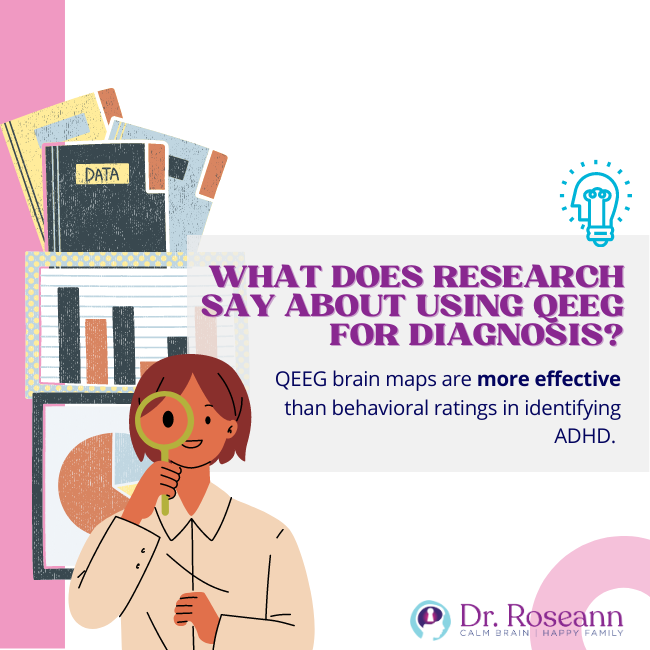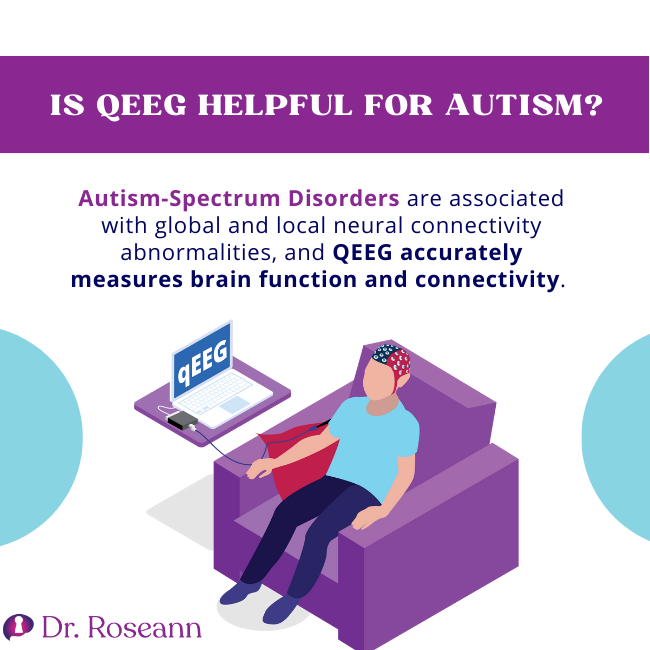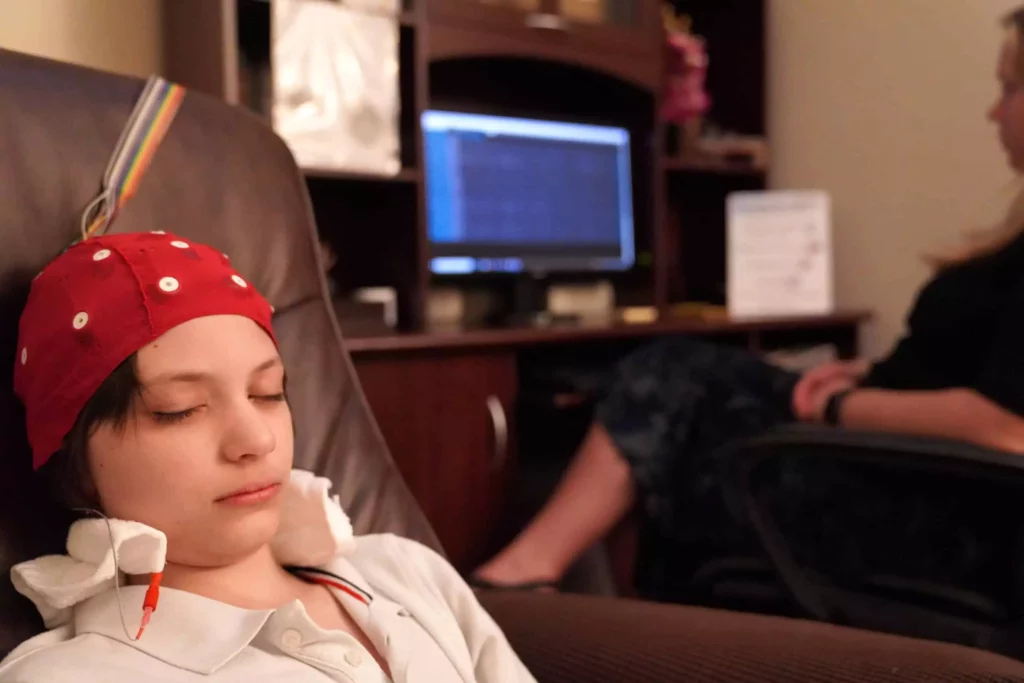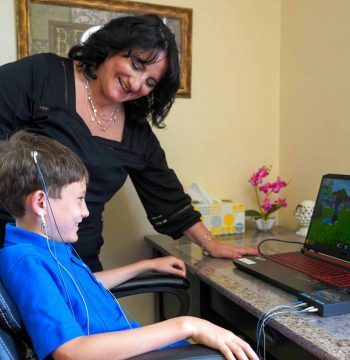The symptoms of ASD (Autism Spectrum Disorder) and ADHD (Attention Deficit Hyperactivity Disorder) often arise due to brain dysregulation. In these disorders, specific brain regions fail to work optimally to process behavioral or emotional control and mental functioning.
While brain dysregulation is more apparent in ASD than in ADHD, both conditions show chaos in the brain network. Since there's no optimal communication between the brain areas, a child with ASD or ADHD feels overwhelmed by the daily demands of their daily lives.
What is a QEEG?
A brain map provides an objective measurement of brainwave activity. It shows how specific regions of the brain function, especially the frontal lobes that control attention. Additionally, it illustrates how the brain processes information and communicates. The brain's communication systems are like highways. These highways or networks make paying attention, learning, and regulating easier.
Using QEEG data, it's possible to determine which areas of the brain have excessive or insufficient brainwave activity and whether there is average, poor, or hyper communication between each region. Based on this visual representation, it's easier to see which parts of the brain are overworked or underworked.
Identifying which regions are overworking or underworking makes it easier to interpret why a child behaves the way they do, as each brain area has a specific function. An overactive limbic system, for instance, would cause emotional and behavioral issues in your child. This information is crucial to helping your child succeed in school, pay attention, and be calm.
A QEEG brain map is an essential first step to neurofeedback to create lasting change in your child. QEEG brain mapping is a tool backed by science that can help with not just ADHD and ASD but also other clinical conditions such as OCD, executive functioning, processing issues, anxiety, depression, PANS/PANDAS, Lyme disease, and learning disabilities.
What Does Research Say About Using QEEG for Diagnosis?

QEEG brain maps are more effective than behavioral ratings in identifying ADHD. Compared to behavioral rating scales, QEEG is 89% accurate as a diagnostic test (Snyder, Quintana, Sexson, Knott, Hague, and Reynolds, 2008). In addition, a QEEG brain map can more effectively determine the root causes of a child's or teen's behavioral, emotional, learning, attentional, or social issues than an interview.
Is QEEG Helpful for ADHD?

During the QEEG scan, the number of slow and fast brain waves is recorded, and the ratio between the two is calculated. The ratio is known to be higher in people with ADHD. However, QEEG shouldn't be the only method used for diagnosing ADHD, but as a complement to the standard diagnostic scale. QEEG is appropriate for kids and teens aged 6 to 17.
One study examined the effects of QEEG-based neurofeedback on inattention (ATT), hyperactivity/impulsivity (HI), and comorbid depression symptoms in 21 patients with ADHD. Following QEEG-informed neurofeedback, ATT, HI, and comorbid depression complaints significantly improved (Arns et al., 2012).
Is QEEG Helpful for Autism?
Autism-Spectrum Disorders are associated with global and local neural connectivity abnormalities, and QEEG accurately measures brain function and connectivity. The QEEG features are sensitive to modifications in neuronal regulation dysfunction, a characteristic of the autistic brain.
Therefore, QEEG may aid in detecting altered brain function and connectivity abnormalities, linking behavior with brain activity, and subgrouping affected individuals within the vast heterogeneity of autism spectrum disorders (Billeci et al., 2013).
What is the Process of a QEEG?
A brain map involves wearing a special cap with built-in sensors and conductivity gel to measure 19 points in your brain. The patient will be asked to close their eyes for 5 minutes to collect data, along with another procedure when the eyes are open. A QEEG is a simple, non-intrusive, and pain-free process for children and adults completed in approximately 15 minutes.
Artifacts, such as eye blinks and other movements, are removed from the data to generate accurate results. After this, the data obtained is compared to a database of others in the same age group. Then, depending on the QEEG software, the reports will give information about each brain structure and how it communicates.
A brain's ability to function inside specific brain regions and to communicate with other brain regions plays a vital role in the treatment. By regulating each, mental health symptoms can be significantly improved.
Is QEEG Safe?
Many are still learning whether a QEEG brain map can be helpful or even harmful since it is a new concept for most. QEEGs are safe. As a method of measuring the surface electrical activity of the brain, the process does not involve any radiological components. Only EEG brainwave data is collected, and a computer processes that data.
It is essential for people with sensory needs to be aware that the QEEG process includes sensory elements. Brain wave activity can only be accurately measured when the cap is snug and conductivity gel is applied. Most people aren't affected, but sensory-sensitive children and adults would appreciate thoughtful comfort planning.
Does QEEG Software Come in Different Types?
Brain wave activity can be measured using various QEEG software and hardware. All QEEG hardware is FDA-approved, and software and hardware selection are primarily determined by the clinician’s preference.
Despite what people say, all QEEG effectively measure surface brain wave activity. The clinician interpreting your QEEG brain map makes the real difference, and we have analyzed thousands of brain maps.
Are QEEGs and EEGs different?
A QEEG differs from an EEG in looking at brain wave activity. Neurologists use EEGs to get raw brain wave data to detect seizures and pre-seizure brain activity. QEEGs analyze EEG at multiple sites and visually represent a person's brain waves. Most QEEGs examine 19 sites, but a few examine up to 200.
What is a QEEG Analysis Like?
Dr. Roseann evaluates the data and takes a clinical intake during a QEEG. Statistics are analyzed and compiled into a digestible report. Brain maps guide and measure treatment during the clinical intake process.
Does Dr. Roseann perform QEEG analysis?

Dr. Roseann interprets every QEEG brain map done through our center and designs customized protocols for each client. Unfortunately, not all neurofeedback providers can analyze and make protocols based on QEEG tests.
Most send the collected data to an outside consultant, which makes it impossible for them to understand it or make changes in real-time. The interpretation of QEEG brain maps requires scientific knowledge and experience, and Dr. Roseann has interpreted thousands of them.
What are the benefits of a brain map for mental health?
Mental health clinicians often make diagnoses based on clinical opinion without using objective data. Using a brain map, we can see which brain areas are active. We use QEEG for our in-person and at-home neurofeedback clients to “check under the hood” and design the right treatment program. For example, the BrainBehaviorResetTM program includes neurofeedback to improve alertness, increase calm, and help kids feel good about themselves.
What role can QEEG data play in tracking treatment progress?

We use a QEEG brain map to track the progress of neurofeedback, biofeedback, CALM PEMF™ therapy, and other treatments. In the past, we have measured the effect of meditation and pre and post-gluten removal on QEEG brain maps. It effectively provides objective data about brain changes. `
Will the QEEG brain map work for my kid?
With QEEG brain mapping, individuals and parents can get accurate information to receive proper treatment. Getting the right treatment is easier if one knows the issue. Dr. Roseann feels that a brain map or a brain check is essential to guiding treatment, which is why she feels so strongly about its importance. All treatment plans are based on it.
Citations
Arns, M., Drinkenburg, W., & Leon Kenemans, J. (2012). The Effects of QEEG-Informed Neurofeedback in ADHD: An Open-Label Pilot Study. Applied Psychophysiology and Biofeedback, 37(3), 171–180. https://doi.org/10.1007/s10484-012-9191-4
Billeci, L., Sicca, F., Maharatna, K., Apicella, F., Narzisi, A., Campatelli, G., Calderoni, S., Pioggia, G., & Muratori, F. (2013). On the Application of Quantitative EEG for Characterizing Autistic Brain: A Systematic Review. Frontiers in Human Neuroscience, 7. https://doi.org/10.3389/fnhum.2013.00442
Snyder, S. M., Quintana, H., Sexson, S. B., Knott, P., Haque, A. F. M., & Reynolds, D. A. (2008). Blinded, multi-center validation of EEG and rating scales in identifying ADHD within a clinical sample. Psychiatry Research, 159(3), 346–358. https://doi.org/10.1016/j.psychres.2007.05.006
Always remember… “Calm Brain, Happy Family™”
Are you looking for SOLUTIONS for your struggling child or teen?
Dr. Roseann and her team are all about solutions, so you are in the right place!
There are 3 ways to work with Dr. Roseann:
You can get her books for parents and professionals, including: It’s Gonna Be OK™: Proven Ways to Improve Your Child’s Mental Health, Teletherapy Toolkit™ and Brain Under Attack: A Resource For Parents and Caregivers of Children With PANS, PANDAS, and Autoimmune Encephalopathy.
If you are a business or organization that needs proactive guidance to support employee mental health or an organization looking for a brand representative, check out Dr. Roseann’s media page and professional speaking page to see how we can work together.
Dr. Roseann is a Children’s Mental Health Expert and Therapist who has been featured in/on hundreds of media outlets including, CBS, NBC, FOX News, PIX11 NYC, The New York Times, The Washington Post,, Business Insider, USA Today, CNET, Marth Stewart, and PARENTS. FORBES called her, “A thought leader in children’s mental health.”

She is the founder and director of The Global Institute of Children’s Mental Health and Dr. Roseann Capanna-Hodge. Dr. Roseann is a Board Certified Neurofeedback (BCN) Practitioner, a Board Member of the Northeast Region Biofeedback Society (NRBS), Certified Integrative Medicine Mental Health Provider (CMHIMP) and an Amen Clinic Certified Brain Health Coach. She is also a member of The International Lyme Disease and Associated Disease Society (ILADS), The American Psychological Association (APA), Anxiety and Depression Association of America (ADAA) National Association of School Psychologists (NASP), International OCD Foundation (IOCDF) International Society for Neurofeedback and Research (ISNR) and The Association of Applied Psychophysiology and Biofeedback (AAPB).
© Roseann-Capanna-Hodge, LLC 2023
Disclaimer: This article is not intended to give health advice and it is recommended to consult with a physician before beginning any new wellness regime. *The effectiveness of diagnosis and treatment vary by patient and condition. Dr. Roseann Capanna-Hodge, LLC does not guarantee certain results.













